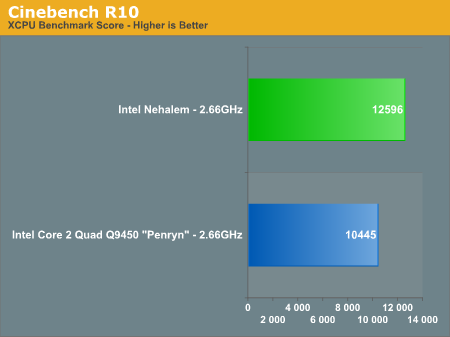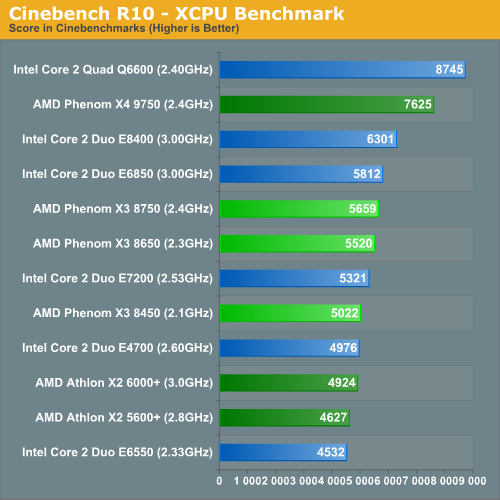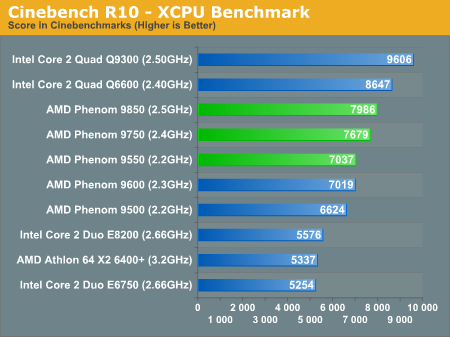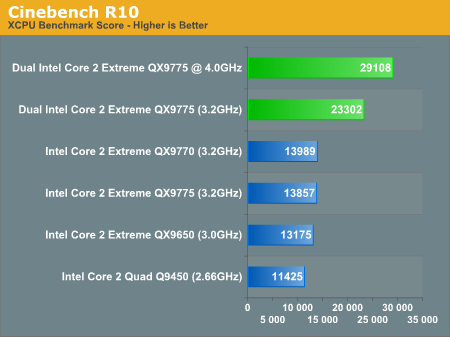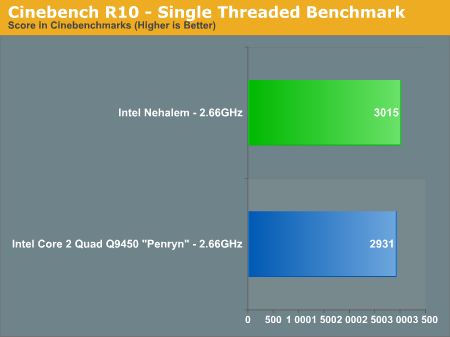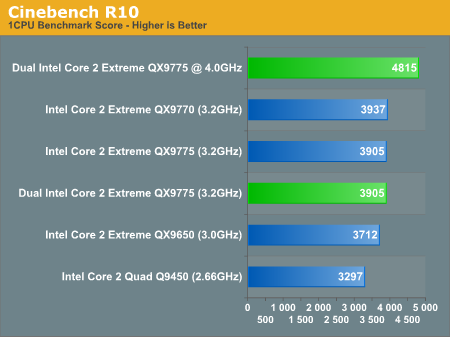Top End Graphics
AMD's newest graphics card has definitely sent shock waves rolling across the graphics landscape.
It is clear from reviews such as Anandtech's The Radeon HD 4850 & 4870: AMD Wins at $199 and $299 that AMD is doing much better in terms of graphics. To be clear, nVidia's GT 280 is still at the top but HD 4870 has managed to surpass GT 260 to take second place. Now, with performance midway between the $400 GT 260 and $650 GT 280 the HD 4870 should be priced at $525. Instead the HD 4870 is a phenomenal bargain at just $300. It looks like nVidia's shiny new GT 200 series is now greatly overpriced. Based on the comparison GT 260 should probably be priced at about $280 and GT 280 at perhaps $350. Nor is nVidia's last minute entry of GeForce 9800 GTX+ much help. This product at $230 is not really better than the $200 HD 4850. Anandtech says:
The Radeon HD 4850 continues to be a better buy than NVIDIA's GeForce 9800 GTX, even if both are priced at $199. The overclocked, 55nm 9800 GTX+ manages to barely outperform the 4850 in a few titles, but loses by a larger margin in others, so for the most part it isn't competitive enough to justify the extra $30.
I have to say though that even when AMD does well there is still subtle bias at Anandtech. For example in the final comments they have to get in this sour note:
You may have noticed better CrossFire scaling in Bioshock and the Witcher since our Radeon HD 4850 preview just a few days ago. The reason for the improved scaling is that AMD provided us with a new driver drop yesterday (and quietly made public) that enables CrossFire profiles for both of these games. The correlation between the timing of our review and AMD addressing poor CF scaling in those two games is supicious. If AMD is truly going to go the multi-GPU route for its high end parts, it needs to enable more consistent support for CF across the board - regardless of whether or not we feature those games in our reviews.
To be perfectly honest I'm a bit floored by this comment. Last minute driver fixes for products that won't even be available for another month shouldn't be too unusual for people who claim to have experience with reviews. That is pretty much the nature of trying to get your reviews out quickly in competition with other websites. Newspapers do the same thing when they chase a breaking story and sometimes they are editing copy right up until it goes to press. This negative comment is even more odd when contrasted with the comment further back in the article:
It is worth noting that we are able to see these performance gains due to a late driver drop by AMD that enables CrossFire support in The Witcher. We do hope that AMD looks at enabling CrossFire in games other than those we test, but we do appreciate the quick turnaround in enabling support - at least once it was brought to their attention.
This seems to be Anandtech schizophrenia at its finest when appreciation for "the quick turnaround in enabling support" turns into suspicion at the "correlation between the timing of our review and AMD addressing poor CF scaling ". Guys, if you read your own text it says that you brought it to AMD's attention and then they sent you an update. We can also see that Anandtech was careful not to end with this comment:
We've said it over and over again: while CrossFire doesn't scale as consistently as SLI, when it does, it has the potential to outscale SLI, and The Witcher is the perfect example of that. While the GeForce GTX 280 sees performance go up 55% from one to two cards, the Radeon HD 4870 sees a full 100% increase in performance.
I assume nVidia must be sweating a bit over a comment like that. This suggests that some more driver work could put dual HD 4870 ahead of nVidia's dual GT 280 in a lot games. This seems especially true when we recall that unlike 3870 X2 the new 4000 series uses a special proprietary inter-processor link instead of using Crossfire. I think we can give credit for that to AMD whose engineers no doubt have lots of experience doing the same thing with CPU's. We've certainly come a long way since AMD's 2900XT last year which although worse in performance than nVidia's 8800 GT still drew a lot more watts. This should also be very good news for Intel. Intel motherboards have by far the weakest integrated graphics compared to nVidia and AMD and really need a boost with an added discrete graphic card. However, Intel motherboards can't do SLI so although Intel is loath to admit it the best graphics on Intel motherboards can only be had with AMD graphic cards using Crossfire. This means that AMD's huge leap in performance with HD 4870 has also just given a big boost to Intel motherboards for gaming.
I'm also a bit doubtful about nVidia's current strategy. nVidia must have been feeling pretty smug last year compared to 2900XT and even the recent shrink to 3870 can't have been too much of a concern. But HD 4870 is a big problem because it performs better than GT 260 but has a much smaller die. This means that nVidia has now just gained a huge liability for 200 and 8800 series inventory out in the field. nVidia will probably have to give rebates to recent wholesale buyers to offset what will almost certainly be substantial reductions in list prices. This also means that nVidia's current inventory has taken a hit as well. Although the 200 series is due for a shrink, the die is so much larger AMD's 4000 series that it is difficult to imagine that nVidia can turn a good profit even at 55nm's. With GT 280 designed for a price point above $600 nVidia is probably going to take a good revenue hit in the next quarter. I wouldn't be surprised to see nVidia change course and start thinking about reducing die size like AMD.
Finally, there should be no doubt at this point that the ATI purchase has turned ATI around giving them both more resources for product development as well as access to a much larger sales force. A rising tide for ATI products is probably some benefit to AMD but obviously AMD has put a great deal of money and resources into the merger. It still appears that AMD had no real choice in the matter but we'll probably have to wait to find out if this relationship has indeed become greater than the sum of its parts.
Some apparently feel that I pick on Anandtech too much so I'll link to some other reviews. Tech Report is considerably more upbeat in their conclusions:
The RV770 GPU looks to be an unequivocal success on almost every front. In its most affordable form, the Radeon HD 4850 delivers higher performance overall than the GeForce 9800 GTX and redefines GPU value at the ever-popular $199 price point. Meanwhile, the RV770's most potent form is even more impressive, in my view. Onboard the Radeon HD 4870, this GPU sets a new standard for architectural efficiency—in terms of performance per die area—due to two things: a broad-reaching rearchitecting and optimization the of R600 graphics core and the astounding amount of bandwidth GDDR5 memory can transfer over a 256-bit interface. Both of these things seem to work every bit as well as advertised. In practical terms, what all of this means is that the Radeon HD 4870, a $299 product, competes closely with the GeForce GTX 260, a $399 card based on a chip twice the size.
You may also get a bit better technical description of the architecture at Tech Reports and you get graphs of games at multiple resolutions.
AMD decided a while back, after the R600 debacle, to stop building high-end GPUs as a cost-cutting measure and instead address the high end with multi-GPU solutions.
This is mostly incorrect. The shaders were increased from 320 to 800 which is definitely a brute force approach to scaling. It appears that what AMD actually did was revamp the memory bus and then apply those power savings to additional shaders. In other words, it appears that AMD's limit is power draw (as born out in a number of reviews) rather an arbitrary stopping point. We also disagree in terms of die size as I believe that AMD has finally gotten dual GPU right by using a proprietary link.
The Legit Reviews article is not nearly as good. There benchmarking is only a fraction of what TR and Anandtech do nor do they have a GT 260 for comparison. However, their most bizarre statement concerns power consumption:
The GeForce GTX 280 has impressive power savings features as you can tell above. The HIS Radeon HD 4870 uses GDDR5 that is supposed to save energy, so they must have had to really increase the core voltage to reach 750MHz. Both the Radeon HD 4850 and HD 4870 use a little more power than we want to see.
From this description you would assume that HD 4870 draws more power than GT 280; this is not the case. In fact, GT 280 draws 20 amps more than HD 4870 under load. Those "impressive power savings" are only seen at idle. So, this characterization is certainly debatable since most computers have sleep or standby modes when they are idle.
The Hexus Review is also missing a GT 260 comparison. I find the author's style of English to be tougher to get information from. I'm not sure whether that is due to his UK heritage or just his heavy tongue in cheek and somewhat meandering writing style. It's probably a bit of both.
Then we have the HardOCP Review which thankfully does include a comparison with GT 260. Their conclusions are:
AMD’s new Radeon HD 4870 and Radeon HD 4850 offer a gigantic performance improvement over their last generation of GPUs and offer great values when compared to NVIDIA new GTX 280 and GTX 260. These performance improvements translate into real-world gaming benefits being able to play at higher resolutions with higher in-game settings utilizing AA and AF.
We were surprised to see the Radeon HD 4870 competing well against the GeForce GTX 260. It not only matched the gameplay experience, but in Assassin’s Creed it edged out with faster framerates too. Count on drivers to mature in both camps as well.
The Radeon HD 4850 is the new sub-$200 video card to beat as it provides the best gameplay experience for the money. It provides a better experience than a GeForce 8800 GT and a GeForce 9800 GTX and is on par with GTX 260 while being less expensive.
While NVIDIA still ultimately holds the single-GPU performance crown with the GeForce GTX 280 it also holds the “Hard to Justify the Price” and “More Money Less Value” crowns with the GTX 280 as well. AMD is now offering the best value in video cards with its 4800 series GPU. And we also see AMD’s drivers maturing more for the 4800 series than we do for the new 200 series from NVIDIA so it is our guess that AMD’s performance will get even better with its new GPUs comparatively.
I pretty much agree with this. We further have yet another reference to maturing drivers. Peddie of Jon Peddie Research even suggested, "Nvidia and ATI keep improving their drivers so they'll seesaw back and forth with their scores, almost from week to week". So, again the notion of some kind of conspiracy as suggested by Anandtech seems to have no connection with reality. Peddie also seems to agree with the idea that nVidia may have to shift to smaller dies.
